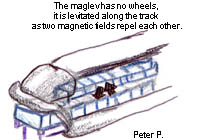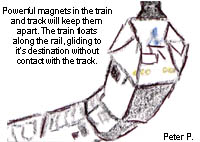St. Mary's High School, Manhasset, NY
|
** Important Disclaimer ** |
||||||||||||||||||||
Maglev – The Flying Train
Typed by Andre P.
-----------------------------------------------------------------------------------------------
![]() Introduction: Written by Marisa S.
Introduction: Written by Marisa S. ![]()
Did you ever believe that you would actually be able to ride on a train that floated above its' own tracks? Well, if you thought it was impossible, guess again. In 1989, a United States Energy Department study finally finalized the recommendation of the latest mode of transportation—the Maglev Train. This $30 billion project was called to link 50 of the nation’s largest urban areas with a network of magnetically levitated super trains.

This incredible study, conducted by the Argonne National Lab, announced that these new trains were quiet, smooth-riding, super fast and even cost effective. Finally, in the fall of 1995, the first train was ready to hit the tracks. Thus, the Maglev was born and the dawning of a new era of transportation began.
The Maglev works by harnessing the strong magnetic power of powerful electromagnets and using this force to propel and lift the train. In effect, this creates extremely little friction between the train and the track thus allowing the train to reach incredible speeds. In addition, because the train is almost totally electrical, it makes the transportation cheaper, faster, and ultimately, much cleaner for the environment. However, this is a very general overview of this amazing power, so if you want to know more, keep reading.
------------------------------------------------------------------------------------------------------------------
![]() Part II: Written by David H.
Part II: Written by David H. ![]()
Maglev trains, otherwise known as Magnetic Levitation Vehicles, are levitated, propelled, and braked by magnetic forces between magnets in the track as well as magnets in the train.
These trains work by magnets, which repel, or push against each other. The magnetic field from the track repels the field from the train causing the Maglev to actually float about six inches off of the guide-way. This means that the train has no contact with the track while in motion, so it is good that magnetic forces can act from a distance.

The magnets in Maglevs are constructed using metals called superconductors. Superconductors are special materials that conduct electricity without losing energy in the process. Built into the bottom of a Maglev are a group of eight coils made of these conductors who are usually made of copper or silver. Some superconductors are made with a mixture of tin and a substance called niobium. This mixture was found to keep its superconductivity when it carries large quantities of currents in a big magnetic field. The movement of the magnets and the copper create currents in the conductor that create magnetic fields that, in turn, levitate, or raise the magnets. Current is known to flow into superconductors more easily than into electromagnets originally planned for use with Maglevs.
------------------------------------------------------------------------------------------------------------------
Bibliography
Gunning, Thomas G. Dream Trains. New York: Dillon, 1992.
Livingston, James D. Driving Force: The Natural Magic of Magnets. Cambridge: Harvard U.P., 1996.